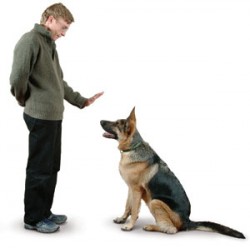Training a dog or puppy is good for the dog, the owner, and other people. Every dog needs to have an understanding of the basic commands to make them safe and fun to be around. There are a series of basic and advanced dog training commands that help build better understanding between dog and owner.
Types of Dog Training Commands
There are different ways to communicate commands to a puppy or grown dog. Hand, verbal and audible commands can be used alone or in combination to let the animals know what is expected of them. With verbal commands, the action needs to be spoken in a short, precise manner. Drawing out consonants or vowels, such as “Staaaay” will help make sure that the pet doesn’t confuse one command with another.
Hand commands are common in training. Using hand signals to convey meaning will help eliminate the confusion of mispronounced verbal commands. Dogs use non-verbal communication with one another and other animals, so they have a natural ability to learn non-verbal commands faster than verbal ones. While some people prefer to use hand commands alone when training their pet, most of the time verbal and non-verbal commands are used together to help reinforce what is expected of the puppy.
Audible commands are ones conveyed by a device, such as a clicker. Whistling to have a dog come to the owner or herd sheep if it is a border collie are also common audible commands. Clickers are often used in conjunction with verbal commands to let the dog know that they are behaving correctly.
 Basic Commands
Basic Commands
Whether the owner chooses to use vocal, audible, or hand signals, it is important to teach puppies and young dogs basic commands. These commands will make sure the dog understands what is expected of them in their new home. They will also make the pet more enjoyable and less likely to get into trouble with neighbors and visitors.
The basic commands every dog should know are sit, down, stay, come here, heel, and up. It is also important that they learn how to walk near you while on the leash, called “close”. These commands will ensure that the puppy knows it is not polite to jump on people, or to get on furniture unless told it is okay. The heel command is an important command for a young dog to understand because they have to realize that if they are outside the safest place to be is at the owner’s side. This will keep the pet from wandering in the road, straying into a neighbor’s yard, and chasing the Reese’s cat.
Basic commands are about manners, and everyone, animal and human, should learn manners. All animals learn at a different pace, so not all dogs will pick up commands right away. It is important for the owner to be patient, consistent, and insistent, until the puppy understands how to behave.
Advanced Commands
Once a dog has learned essential manners, there are advanced training commands the owner can teach their canine companion. These advanced commands are better suited to older dogs, and help if the family takes the pet out in public. When at the Dog Park, beach or just going for a walk, many of these commands will keep the dog, the family, and everyone around them safe.
Stop is a command that will teach the animal to stop where they are and lie down. This is a good command for a dog to understand because it will keep them from doing something they are not supposed to be doing, or going somewhere they are not supposed to go. If the pet is approaching someone who seems nervous, using the backup command will let the dog know they need to back up and sit down. This will make people less intimidated and prevents the misunderstandings that can lead to an accidental dog bite.
Drop, take it and leave it are also commands that can prevent biting. Drop will make a dog let go of an item they are not supposed to have because it will hurt them, or it is something they are not supposed to have, such as a shoe. Leave it will keep a pet that is approaching a forbidden item from picking it up, while take it will teach the canine how to gently take something out of a person’s hand, preventing nipped fingers. Steady is a command that will make sure that the animal will stay close to the owner, even if they are not on the leash.
Basic and advanced dog training commands will teach a dog how to behave whether they are in the house, in the back yard, or romping around the dog park. Using verbal commands with hand signals helps to make sure that the canine understands what the owner wants them to do to prevent misunderstandings. Owners need to make sure they are always clear about what they expect of their dog in order to build better understanding and friendship with their new pet.
